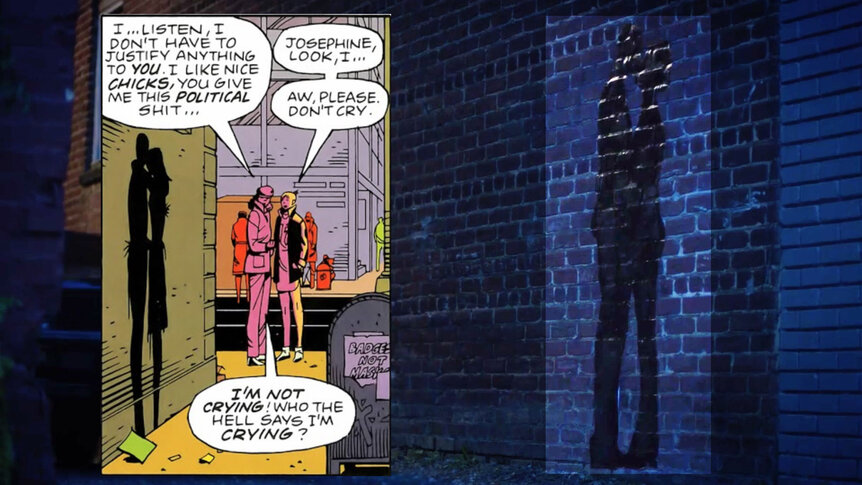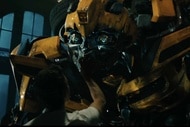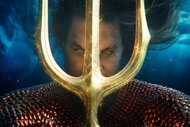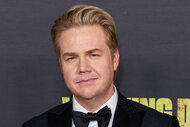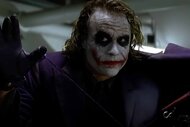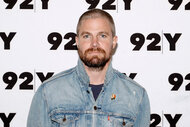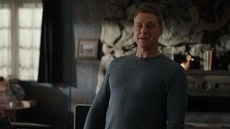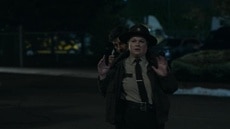Every Easter egg and comic reference in Episode 2 of HBO's Watchmen
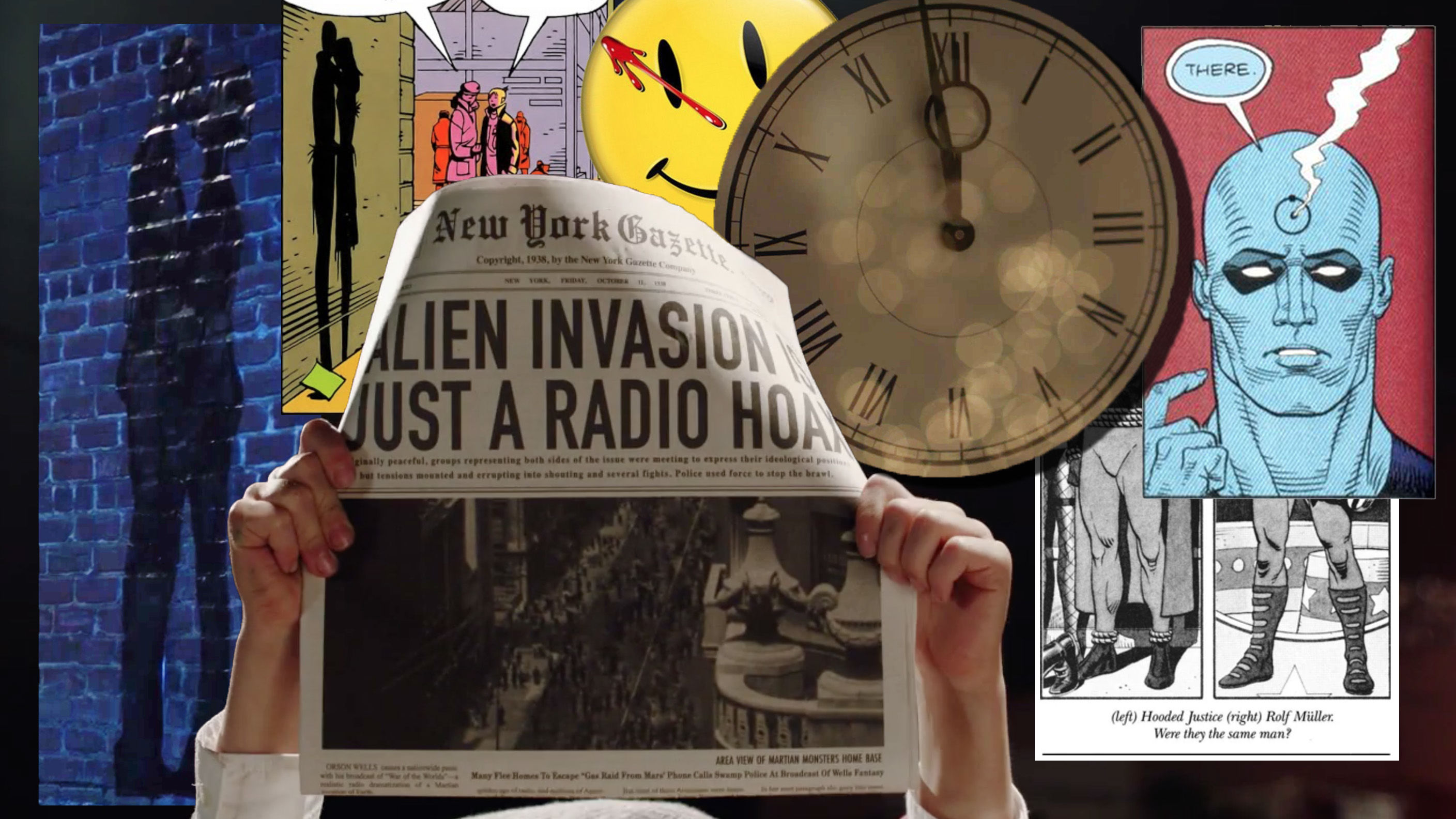
Watching HBO's Watchmen is a little like looking at a Rorschach ink blot — when it comes to Easter eggs, sometimes you'll see things that others won't.
As we explained in our recap of the first episode's Easter eggs and references, which featured an interview with Nichole Kassell, who directed the first two episodes, there are so many subtle and overt homages to Alan Moore's seminal graphic novel that cataloging all of them is a tricky task. But we're up for the challenge, so here's every Easter egg and otherwise noteworthy reference that SYFY WIRE found in the second episode of Watchmen.
We will update this list with any we might have missed — and there almost certainly will be some. Like we said, there are a lot of Easter eggs in this show.
FRAULEIN MUELLER
In the cold open, a WWI German military official dictates a propaganda letter to an English-speaking typist with the surname "Mueller." Later in the episode, during the "American Hero Story" section, we learn that the body of a German circus strongman named Rolf Müller washed ashore with a bullet in the back of his head and that he's erroneously believed to be Hooded Justice. Supplementary material in the comics reveals that Müller was a serial killer, and that while the first Nite Owl and many others suspected him of being Hooded Justice, though that was not the case. (The prequel comic series Before Watchmen complicates this story, though it's unclear if those comics are canon to the show).
In any case, the masked vigilante's true identity remains a mystery. But, was Rolf Müller related to the German typist, or are the similar surnames (Mueller is a variant spelling of Müller) just a little wink to the audience?
MARTIAL FEATS OF COMANCHE HORSEMANSHIP
The episode gets its name from an 1834 George Catlin painting, Comanche Feats of Horsemanship, although it remixes the title a little bit. The actual painting (or a copy of it, as in the real world it's housed in the Smithsonian American Art Museum) appears in the Crawfords' home later in the episode.
MAYBE I'M DOCTOR MANHATTAN
Will Reeves taunts Angela by implying that he's Doctor Manhattan, only for Angela (and later others) to insist that he "can't look like us." Doctor Manhattan's powers make him nigh-omnipotent, but although he can change his skin tone to be a darker blue, he apparently isn't a shape-shifting master of disguise.
HIROSHIMA LOVERS
It's quick and a little tricky to see, but when Angela drives away from her bakery, she passes some familiar street art. It's the silhouette of two people embracing, and an almost identical work of art appeared in the original graphic novel, where it was a frequently seen graffiti tag in New York City. Rorschach didn't like it, while his ill-fated psychiatrist Malcolm Long likened it to the silhouette of victims of the atomic bomb, dubbing the pair "Hiroshima Lovers." In the comic, they're symbolic of the imminent nuclear/squid disaster. What deeper meaning they have for the TV show is as-yet unclear.
THE NEW FRONTIERSMAN
Angela also drives by Mister News, because print isn't dead in the pre-Internet world of Watchmen. There's a copy of The New Frontiersman, the somewhat fringey publication to which Rorschach entrusted his journal at the end of the comic. The front page reads "Global Squidfalls Baffle Scientists," which further shows the scope and scale of those squid rains we saw in Episode 1.
KEENE TO RUN FOR PRESIDENT
Senator Joe Keene, the presumed son of Senator John David Keene — the man responsible for the 1977 Keene Act, which outlawed superheroes — is making a run for the nation's highest office now that Redford won't be running for another term.
MISTER NEWS
The newsstand and its jovial assortment of workers and patrons more generally echo Bernard's newsstand from the graphic novel. That said, everyone seems a lot happier in 2019 than they did in 1985, when all the headlines were about the Cold War and imminent nuclear death.
MOTHMAN-STYLE PAPARAZZI
The two photographers who try to capture pictures of the crime scene are flying using bug-like wing contraptions that resemble those worn by Mothman, one of the original Minutemen. The Before Watchmen series about the Minutemen explained that Mothman, a man named Byron Lewis, had to maintain a very strict and consistent weight in order to fly, and that he crashed often. Presumably, his wing technology has been emulated if these photographers have some — and it seems like it's been improved on, although those things still seem pretty janky.
TWO MINUTES TO MIDNIGHT
During the flashback to the White Night, Cal, who is eager to open his Christmas presents, mentions that it's two minutes to midnight. This is a clear allusion to the Doomsday Clock, a real-life metaphor for how close humanity is man-made global catastrophe. The more minutes away from midnight the members of the Bulletin of the Atomic Scientists think we are, the less likely global catastrophe is. (Fun fact: Due to climate change and nuclear weapon proliferation, we're currently at two minutes to midnight, which is tied for the closest to midnight we've ever been alongside 1953, when the Soviet Union first began testing Hydrogen Bombs).
The Doomsday Clock was an important symbol in the original graphic novel, as a clock on the cover of all 12 issues gradually counting down the minutes until disaster.
THE CLOCK LOOKS LIKE DOCTOR MANHATTAN'S SYMBOL
The face of the Abars' clock looks a bit like Doctor Manhattan's symbol, the atomic structure of hydrogen.
WAS THAT WILL'S DAD IN THE GREENWOOD CENTER FOR CULTURAL HERITAGE?
When Angela walks into the Greenwood Center for Cultural Heritage to test Will's DNA, she walks by some holograms in the museum. It's hard to tell given the fuzzy nature of the holograms, but there's a WWI soldier who looks like Will's dad, as seen in the opening of the episode. Even if it's not actually him, the hologram is espousing a similar sentiment to what he must have been thinking after getting that German letter.
HENRY LOUIS GATES JR.
In the real world, Henry Louis Gates Jr. is a Harvard University professor and a prominent scholar and literary critic, specializing in African-American history and culture. He's also the host of PBS' Finding Your Roots. In Watchmen, he's Robert Redford's Secretary of Treasury and the digital greeter at the Greenwood Center for Cultural Heritage. (Some supplementary materials HBO released reveal that Vox co-founder Ezra Klein is the Press Secretary).
539-176-2442
Angela gives her phone number, and it does not start with 555, meaning it's a real number. As of Friday, when this post was written, though, the number is not in service if you call it. No Easter egg here.
PIRATES AND OWL COSTUMES
When Cal is playing with the younger kids, one is dressed up as an owl (another Nite Owl reference) while the other is a pirate. In Watchmen, pirate stories were a huge genre (superhero comics aren't as interesting when there are real-life superheroes everywhere), and we saw a lot of the comic-with-a-comic, Tales of the Black Freighter.
MAGNA-HATTAN BALLS
Topher is playing with a very complex, levitating building toy that the box reveals are called "Magna-Hattan Balls," presumably inspired by Doctor Manhattan's abilities.
THE PERSISTENCE OF MEMORY
Topher has a copy of Salvidor Dali's The Persistence of Memory on his wall. The iconic surrealist painting is famed for its melting clocks, and clocks are, again, a huge motif in Watchmen.
ALIEN INVASION HOAX
This Easter egg is pretty hard to miss, as when American Hero Story flashes back to 1938, a paperboy is holding a front page with a big headline about an alien invasion being a hoax. No, it's not Ozymandias' interdimensional squid, but a reference to Orson Welles' infamous War of the Worlds broadcast, which caused a minor panic when listeners in the New Jersey area though the alien invasion was really happening.
ZACK SNYDER, IS THAT YOU?
Maybe the show's creators wouldn't admit it, but all the gratuitous violence and use of slow-motion in the American Hero Story segment has to be an allusion to Zack Snyder's take on Watchmen in the 2009 movie.
FLOWERS
Here's a great example of how subtle and hard to spot Watchmen's Easter eggs are. In an interview with SYFY WIRE, Episode 1 and 2 director Nichole Kassell explained that even tiny choices were references to the original graphic novel. "Regina at some point carries some flowers," Kassell said, referring to Angela's arrival to the Crawford house. "And the opening of the book is so iconic with the red bouquet, so there was no doubt that we were going to do that," she continues, alluding to a moment early in the second issue when Laurie Juspeczyk brings her mother Sally Jupiter flowers after news of the Comedian's death breaks.
NITE OWL GOGGLES
When Angela is digging around Judd Crawford's closet she's wearing night-vision goggles, which seem like they might be a version of Nite Owl's technology, like the Owlship in Episode 1. HBO's supplemental material revealed that the second Nite Owl (Dan Dreiberg) was arrested after he and Laurie attempted to make a return to costumed crime-fighting in violation of the Keene Act. Perhaps he turned over his technology to the authorities as part of a deal?
DOCTOR MANHATTAN'S ORIGIN STORY
The play that Adrian Veidt writes isn't subtle enough to be an Easter egg, as it's pretty explicitly a reenactment of the accident that transformed Jon Osterman into Doctor Manhattan. Still worth noting here just in case.
"AS IMPENETRABLE AS THE GORDIAN KNOT ITSELF"
The dialogue in the play is extremely Ozymandias-core, as Adrian Veidt was a fan of the classics. The legendary knot was said to be impossible to untangle, but Alexander the Great solved the puzzle by simply cutting the knot apart with his sword. Adrian recounts this very story in the graphic novel, and there's also a lock company called the Gordian Knot Lock Co., which could be a subsidiary of Veidt Enterprises.
NOTHING ENDS, JANEY. NOTHING EVER ENDS
The play concludes with the servant playing Janey asking "Is this the end," and the servant playing Doctor Manhattan responds with "Nothing ends, Janey, Nothing ever ends." A somewhat forlorn-looking Adrian speaks the end of the quote aloud, as it's something that the real Doctor Manhattan told him in the graphic novel when Adrian asked if he did the right thing "in the end" by killing three million people to avert the Cold War. Perhaps Adrian, wherever he might be, is all too aware of how true Doctor Manhattan's words were.

